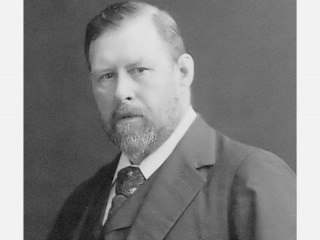
Bram Stoker biography
Date of birth : 1847-11-08
Date of death : 1912-04-20
Birthplace : Clontarf, Ireland
Nationality : Irish
Category : Famous Figures
Last modified : 2011-01-24
Credited as : Author and novelist, author of Dracula,
Bram Stoker is best known as the author of Dracula (1897), one of the most famous horror novels of all time.
Abraham Stoker was born in Clontarf, Ireland in 1847. He was a sickly child, bedridden for much of his boyhood. As a student at Trinity College, however, he excelled in athletics as well as academics, and graduated with honors in mathematics in 1870. He worked for ten years in the Irish Civil Service, and during this time contributed drama criticism to the Dublin Mail. His glowing reviews of Henry Irving's performances encouraged the actor to seek him out. The two became friends, and in 1879 Stoker became Irving's manager. He also performed managerial, secretarial, and even directorial duties at London's Lyceum Theatre. Despite an active personal and professional life, he began writing and publishing novels, beginning with The Snake's Pass in 1890. Dracula appeared in 1897. Following Irving's death in 1905, Stoker was associated with the literary staff of the London Telegraph and wrote several more works of fiction, including the horror novels The Lady of the Shroud (1909) and The Lair of the White Worm (1911). He died in 1912.
Although most of Stoker's novels were favorably reviewed when they appeared, they are dated by their stereotyped characters and romanticized Gothic plots, and are rarely read today. Even the earliest reviews frequently decry the stiff characterization and tendency to melodrama that flaw Stoker's writing. Critics have universally praised, however, his beautifully precise place descriptions. Stoker's short stories, while sharing the faults of his novels, have fared better with modern readers. Anthologists frequently include Stoker's stories in collections of horror fiction. "Dracula's Guest," originally intended as a prefatory chapter to Dracula, is one of the best known.
Dracula is generally regarded as the culmination of the Gothic vampire story, preceded earlier in the nineteenth century by Dr. William Polidori's "The Vampyre," Thomas Prest's Varney the Vampyre, J. S. Le Fanu's Carmilla, and Guy de Maupassant's "Le Horla." A large part of the novel's initial success was due, however, not to its Gothicism but to the fact, noted by Daniel Farson, that "to the Victorian reader it must have seemed daringly modern." An early reviewer of Dracula in the Spectator commented that "the up-to-dateness of the book—the phonograph diaries, typewriters, and so on—hardly fits in with the mediaeval methods which ultimately secure the victory for Count Dracula's foes." Stoker utilized the epistolary style of narrative that was characteristic of Samuel Richardson and Tobias Smollett in the eighteenth century, and that Wilkie Collins further refined in the nineteenth. The narrative, comprising journal entries, letters, newspaper clippings, a ship's log, and phonograph recordings, allowed Stoker to contrast his characters' actions with their own explications of their acts.
Some early critics noted the "unnecessary number of hideous incidents" which could "shock and disgust" readers of Dracula. One critic even advised keeping the novel away from children and nervous adults. Initially, Dracula was interpreted as a straightforward horror novel. Dorothy Scarborough indicated the direction of future criticism in 1916 when she wrote that "Bram Stoker furnished us with several interesting specimens of supernatural life always tangled with other uncanny motives." In 1931 Ernest Jones, in his On the Nightmare, drew attention to the theory that these "other uncanny motives" involve repressed sexuality. Critics have since tended to view Dracula from a Freudian psychosexual standpoint; however, the novel has also been interpreted from folkloric, political, feminist, medical, and religious points of view.
Today the name of Dracula is familiar to many people who may be wholly unaware of Stoker's identity, though the popularly held image of the vampire bears little resemblance to the demonic being that Stoker depicted. Adaptations of Dracula in plays and films have taken enormous liberties with Stoker's characterization. A resurgence of interest in traditional folklore has revealed that Stoker himself did not conform to established vampire legend. Yet Dracula has had tremendous impact on readers since its publication. Whether Stoker evoked a universal fear, or as some modern critics would have it, gave form to a universal fantasy, he created a powerful and lasting image that has become a part of popular culture.
Concise Dictionary of British Literary Biography, Volume 5: Late Victorian and Edwardian Writers, 1890-1914, Gale, 1991, pp. 310-16.
<















